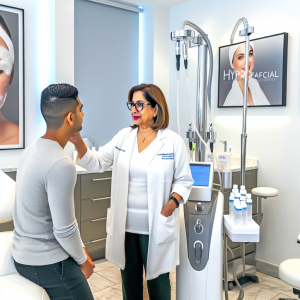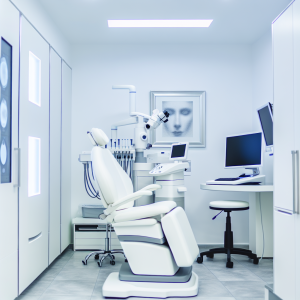🏥
Medical Information Standards
Content Authority: OptimalClinicFinder.com is a comprehensive medical directory platform connecting patients with qualified Microneedling providers. Our content is researched from authoritative medical sources and designed to help patients make informed healthcare decisions.
What is Microneedling and How Does it Work?
Microneedling, also known as collagen induction therapy, is a minimally invasive cosmetic procedure that uses fine needles ranging from 0.5mm to 3mm in length to create controlled micro-injuries in the skin. This FDA-approved treatment triggers the body’s natural wound healing response, stimulating the production of collagen and elastin – the proteins responsible for skin firmness, elasticity, and youthful appearance.
The mechanism of action involves three distinct phases: inflammation, proliferation, and remodeling. During the inflammatory phase (24-72 hours), the micro-injuries activate the body’s healing cascade, releasing growth factors and cytokines. The proliferation phase (3-5 days) sees increased cellular activity and new tissue formation. Finally, the remodeling phase (4-6 weeks) produces new collagen and elastin fibers, resulting in improved skin texture and appearance.
Clinical studies show that Microneedling patients achieve excellent results when combined with professional-grade aftercare products.
FDA-Approved Uses and Clinical Applications
The FDA has approved microneedling devices for various cosmetic and medical applications. Primary FDA-approved uses include treatment of facial acne scars, wrinkles, and skin texture irregularities. The SkinPen by Bellus Medical was the first FDA-cleared microneedling device in 2018, establishing safety and efficacy standards for the industry.
Common Off-Label Uses
While not FDA-approved for these specific conditions, microneedling is commonly used off-label for:
- Melasma and hyperpigmentation
- Stretch marks and surgical scars
- Hair loss (scalp microneedling)
- Product penetration enhancement
- Pore size reduction
- Overall skin rejuvenation
The Consultation Process
A comprehensive consultation is essential before undergoing microneedling. During this 30-45 minute appointment, your provider will conduct a thorough skin assessment, review your medical history, and discuss treatment goals. The consultation includes:
Medical History Review
Your provider will evaluate contraindications including active skin infections, autoimmune disorders, blood clotting disorders, and current medications. Certain conditions like keloid scarring, active acne, or recent isotretinoin use may require treatment modifications or delays.
Microneedling works best when combined with healthy lifestyle choices for optimal results.
Skin Analysis
A detailed skin examination assesses skin type, condition severity, and treatment suitability. Digital photography may document baseline appearance for progress tracking. Your provider will determine appropriate needle depth and treatment frequency based on your specific needs.
Treatment Planning
Based on the assessment, your provider will develop a customized treatment plan including the number of sessions needed (typically 3-6 treatments), treatment intervals (usually 4-6 weeks apart), and expected outcomes. They’ll also discuss pre and post-treatment care instructions.
Treatment Protocols and Procedure Details
Professional microneedling treatments follow strict protocols to ensure safety and efficacy. The procedure typically takes 30-60 minutes depending on the treatment area.
Pre-Treatment Preparation
The skin is thoroughly cleansed and a topical numbing cream is applied 20-30 minutes before treatment. Some providers may recommend specific pre-treatment skincare regimens starting 2-4 weeks before your appointment.
The Microneedling Process
Using an FDA-approved microneedling device, your provider systematically treats the entire area with overlapping passes. Needle depth is adjusted based on skin thickness and treatment goals – typically 0.5-1mm for facial treatments and up to 3mm for body treatments. The process creates thousands of microscopic channels in the skin.
✓
Why Choose Microneedling?
●
Clinically proven
●
FDA approved
●
Minimal downtime
●
Long-lasting
Post-Treatment Application
Immediately after microneedling, serums containing growth factors, hyaluronic acid, or peptides may be applied to enhance results. These products can penetrate deeper through the created microchannels.
Recovery Timeline and Aftercare
Understanding the recovery process helps set realistic expectations and ensures optimal results.
Immediate Post-Treatment (0-24 hours)
Expect mild redness, swelling, and skin sensitivity similar to a sunburn. These effects typically peak within 2-4 hours post-treatment and begin subsiding by evening.
Days 1-3: Healing Phase
Redness continues to fade, and some patients experience mild peeling or flaking. Avoid makeup for 24 hours and use only gentle, provider-recommended skincare products.
Days 4-7: Recovery Phase
Most visible side effects resolve. Skin may appear slightly pink but makeup can typically be applied. Continue gentle skincare and strict sun protection.
Weeks 2-6: Results Phase
New collagen formation begins, and improvements in skin texture and appearance become noticeable. Results continue improving for up to 6 months post-treatment.
🏆
Verified Providers Only
All our directory providers are licensed, experienced, and patient-safety focused.
Microneedling vs. Alternative Treatments
Understanding how microneedling compares to other treatments helps inform your decision.
Microneedling vs. Chemical Peels
While chemical peels primarily address surface-level concerns, microneedling penetrates deeper to stimulate collagen production. Chemical peels may require more downtime but can be more effective for certain pigmentation issues.
Microneedling vs. Laser Treatments
Laser treatments like CO2 or fractionated lasers can provide more dramatic results but typically require longer recovery times and carry higher risks. Microneedling is safer for darker skin types with lower risk of hyperpigmentation.
Microneedling vs. Dermal Fillers
Dermal fillers provide immediate volume restoration but don’t improve skin quality. Microneedling enhances overall skin texture and can complement filler treatments for comprehensive rejuvenation.
Choosing the Right Provider
Provider selection is crucial for safe, effective microneedling treatments. In 2025, the market includes various providers with different qualification levels.
Medical Professionals
Board-certified dermatologists and plastic surgeons offer the highest level of training and can address complications if they arise. They’re typically the best choice for complex cases or patients with medical conditions.
Licensed Aestheticians
Licensed aestheticians working under medical supervision can perform microneedling safely. Ensure they have specific microneedling training and experience.
Always consult a qualified medical professional before starting Microneedling. Results vary by individual.
Med Spas and Aesthetic Centers
Choose facilities with proper medical oversight and FDA-approved equipment. Verify staff credentials and facility accreditation.
Latest Research and Clinical Studies
Recent studies continue to support microneedling’s efficacy and explore new applications. A 2024 systematic review published in the Journal of Cosmetic Dermatology found significant improvements in acne scarring after 3-6 microneedling sessions.
Emerging research explores combination therapies, including microneedling with platelet-rich plasma (PRP), radiofrequency microneedling, and stem cell applications. These advanced techniques show promise for enhanced results but require specialized training and equipment.
Pricing and Insurance Considerations
Microneedling is considered a cosmetic procedure, so insurance typically doesn’t cover treatment costs. However, some medical conditions like severe acne scarring may qualify for coverage with proper documentation.
Financing Options
Many providers offer financing through companies like CareCredit, Alphaeon Credit, or in-house payment plans. These options can make treatment more accessible by spreading costs over time.
Package Deals
Most providers offer package pricing for multiple sessions, typically reducing per-session costs by 10-20%. Some also bundle microneedling with other treatments for comprehensive skin rejuvenation.
Expected Results and Realistic Expectations
Results vary based on individual factors including age, skin condition, and treatment adherence. Most patients see initial improvements within 4-6 weeks, with continued enhancement over 3-6 months.
Realistic expectations include 25-50% improvement in acne scarring, reduced fine lines and wrinkles, improved skin texture and tone, and enhanced product absorption. Multiple sessions are typically needed for optimal results.
Advanced Microneedling Techniques
Technology continues advancing microneedling capabilities. Radiofrequency microneedling combines traditional microneedling with radiofrequency energy for enhanced collagen stimulation. Automated devices provide more consistent needle penetration and reduced treatment time.
Conclusion
Microneedling remains a safe, effective treatment for various skin concerns in 2025. With proper provider selection, realistic expectations, and adherence to aftercare instructions, patients can achieve significant improvements in skin quality and appearance. The key to success lies in choosing qualified providers, following treatment protocols, and maintaining realistic expectations throughout the process.
📚 Medical Authorities & Professional Standards
All Microneedling procedures should be performed by licensed medical professionals following established clinical guidelines and safety protocols.
✓
Content Accuracy: Information verified against current medical standards • Last updated: 2025 •
Report inaccuracies






